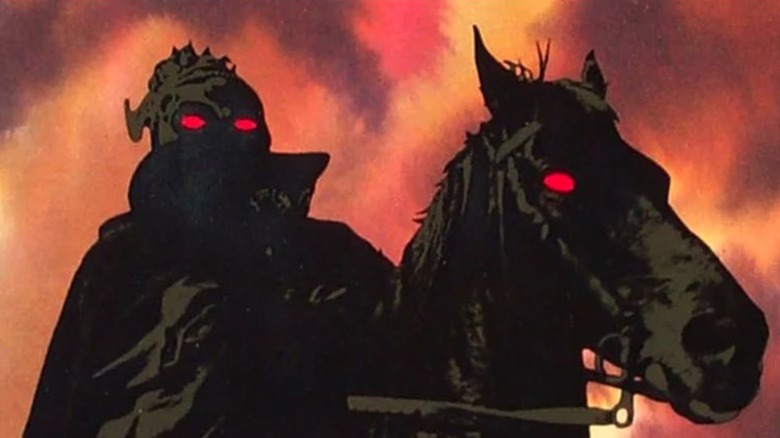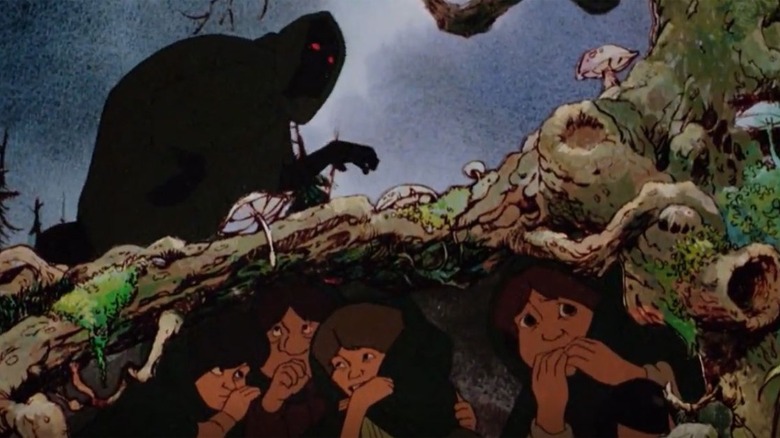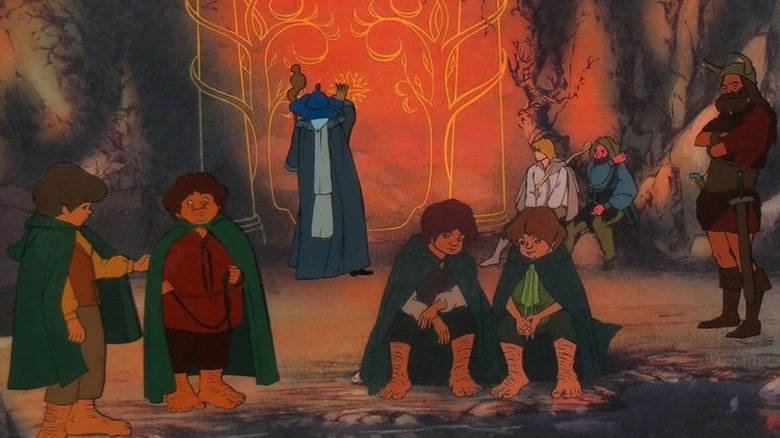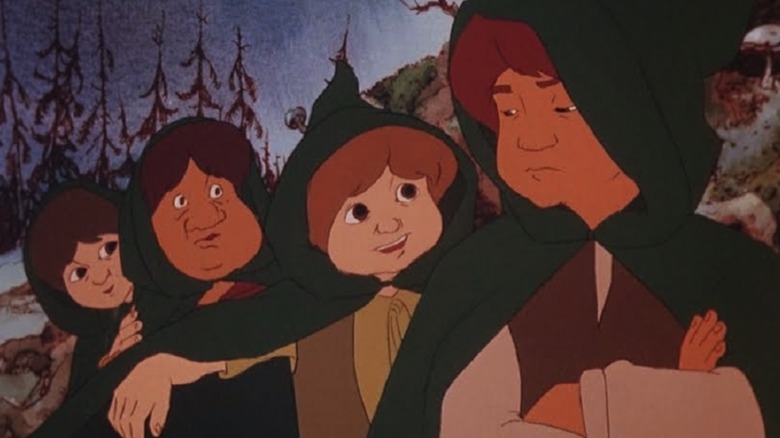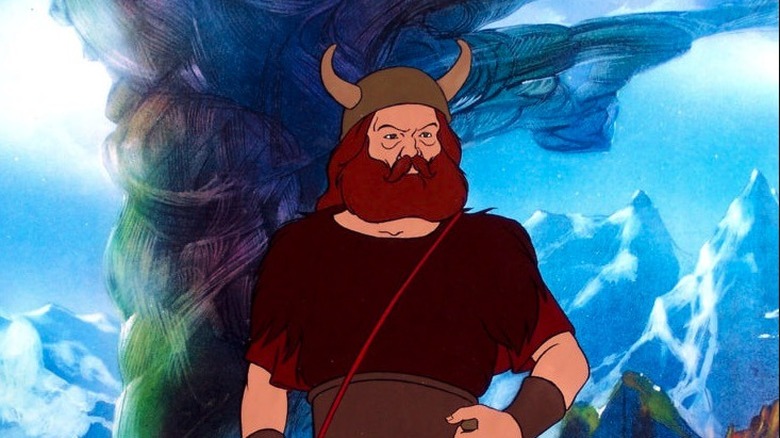How Ralph Bakshi Rescued The Animated Lord Of The Rings
We may receive a commission on purchases made from links.
Ralph Bakshi's animated 1978 "Lord of the Rings" messed me up as a child. I still have nightmares about so many parts of it. As a kid growing up in the 1980s, the animation I saw was very pretty and clean and full of "life lessons." When I finally saw this, it was grimy and weird, and the music was strange. It was outside of my kid wheelhouse, and to this day, it has informed the way I think about movies. By that I mean, it taught me that things that are different, things that really stick out, are often the ones you remember.
Bakshi's work remains striking and terrifying. What you might not know is that Bakshi wasn't asked to do the film. He campaigned for "The Lord of the Rings" to save it from being made into a single live-action film.
He said in an interview with The One Ring, "First of all — no one ever asked me to make 'The Lord of the Rings' ... " He said that he went from United Artists to MGM and tried to get the adaptation of the J.R.R. Tolkien book done in multiple films. (There only ended up being one.) He already had a script, but it got a negative response.
"It wasn't a major property in those days! No one knew it — everyone hated it ... They couldn't read all those books. And that's why I got it, because I knew it was great. The guy they gave it to couldn't do it; he didn't understand it. He took three books and tried to make one picture with new characters; maybe he put Superman in there too, I don't know..."
Where There's a Will, There's a Way
Oof. "The Lord of the Rings" is certainly a property that you cannot do if you think it seems too long to read. Squeezing it into a single, live-action film would have absolutely destroyed it. It certainly wouldn't have paved the way for the Peter Jackson trilogy. John Boorman, who wrote the single-movie script, made a great and very strange high-fantasy film in "Excalibur," but you just can't take this much material that means so much to people and squash it into two hours. Unfortunately, they way the animated film was advertised was odd.
Bakshi told IGN about the experience:
I was doing it to save it for Tolkien, because I loved the 'Rings' very much. I had just finished 'Wizards.' 'Wizards' was my homage to Tolkien in the American idiom. I had read Tolkien, understood Tolkien, and wanted to do a sort of fantasy for American kids, and that was 'Wizards' and I love it very much. Of course it's American as opposed to Tolkien.
But when I heard that United Artists was going to collapse the three books into one picture and there was a screenplay written by (John) Boorman, I thought it best that I go down and tell them they're out of their minds. Because I was nuts over Tolkien. I mean, Tolkien for me was one of the greatest fantasy writers of all time. But the amount of effort and time that I put into it, and then to have the advertising that gave the audiences the impression that it was a complete picture and not part of three, and the fact that I had to do it in a year and a couple of months – it burnt me out. It was the hardest thing I ever had to do, to do 2 1/2 hours of animation in a year. I think it took more out of me then I got back, yeah.
Speak, Friend, and Enter
I'm going to throw this out there: Is it worse to combine the entirety of "The Lord of the Rings" into a single film as Bakshi mentions, or to take a small book like "The Hobbit" and turn it into three very long films? I don't know which the lesser of two evils is, but "The Hobbit" films were a bit of a mess. Neither option is good. That said, back in the late '70s, doing a "Lord of the Rings" film outside of animation would have been, shall we say, a challenge.
Bakshi spoke to It Came From ... and explained the process of what happened, from the $3 million the studio had paid Boorman for the single film script, to walking across the hall from United Artists to MGM to see if he could do it himself, to how he got the rights.
Our Hero
Bakshi explained:
"I thought, 'Wait a minute, why don't I go make the film?' So I call up Mike Medavoy and I go to United Artists, which in those days were on the same lot as MGM. In the main building on one side of the building was MGM — which Dan Melnick ran in those days — and on the other side was Mike Medavoy at UA. I went to see Mike in his office and he says, 'Look, I've got this script and I don't understand it. I never read the book. We don't want to make the picture. What do you want to do?' I said, 'I want to animate it. Three pictures.' He said, 'We don't want the picture. What we want is our three million dollars back for the screenplay that we paid Boorman. So I'll give you the rights, and if you can get our money back you can make the picture any way you want.' True story."
He attempted to convince Dan Melnick at MGM:
"We crossed the hallway to Medavoy's office and Danny says to Mike, 'Okay, I want to make the film with Ralph. What do you want?' And Mike says, 'Three million dollars for my screenplay back. And Melnick says, 'You got it.' They shake hands. Medavoy, whose job was just saved, gets on his feet and shakes my hand, almost crying. I got back his money. He was off the hook."
A Vision That Influenced the Future
They made the deal that day. Bakshi said:
"So I've got the rights, I've got the film financing from MGM, Medavoy's off the hook, I'm going to make three pictures, and I've also got $200,000 to start the storyboards. It wasn't a bad day's work, right?"
The film may have ended with the battle at Helm's Deep, and that confused audiences, but at least it got made. Not only did we get to see the adventures of Frodo and Gandalf, but we got it in a way that is burned into the brains of a generation. Bakshi also did this in a way that stayed very true to most of Tolkien's work. This animated film is what got me and so many other kids to read "The Lord of the Rings." A film getting kids to read books is a legacy all on its own.
Fun fact: Anthony Daniels, aka C-3PO, voiced the role of Legolas. Mull that over in your nugget for a bit.
